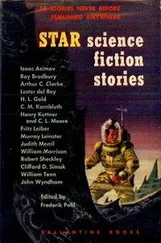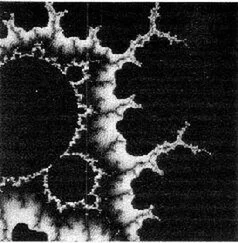“I was hoping you could tell us something about it.”
“We don’t know a hundredth of the creatures in the Lassan sea. One day we’ll build some research subs and go into deep water. But there are so many other priorities, and not enough people are interested.”
They soon will be, Lorenson thought grimly. Let’s see how long Brant takes to notice for himself…
“Science Officer Varley has been checking the records. She tells me that there was something very much like this on Earth millions of years ago. The paleontologists gave it a good name — sea scorpion. Those ancient oceans must have been exciting places.”
“Just the sort of thing Kumar would like to chase,” Brant said. “What are you going to do with it?”
“Study it and then let it go.”
“I see you’ve already tagged it.”
So Brant’s noticed, thought Loren. Good for him.
“No — we haven’t. Look more carefully.”
There was a puzzled expression on Brant’s face as he knelt at the side of the tank. The giant scorpion ignored him completely as it continued to snip away at the seaweed with its formidable pinchers.
One of those pinchers was not altogether as nature had designed it. At the hinge of the right-hand claw there was a loop of wire twisted round several times like a crude bracelet.
Brant recognized that wire. His jaw dropped, and for a moment he was at a loss for words.
“So I guessed right,” Lorenson said. “Now you know what happened to your fish trap. I think we’d better talk to Dr. Varley again — not to mention your own scientists.”
“I’m an astronomer,” Anne Varley had protested from her office aboard Magellan. “ What you need is a combination of zoologist, paleontologist, ethologist — not to mention a few other disciplines. But I’ve done my best to set up a search program, and you’ll find the result dumped in your Bank 2 under file heading SCORP. Now all you need to do is to search that — and good luck to you.”
Despite her disclaimer, Dr. Varley had done her usual efficient job of winnowing through the almost-infinite store of knowledge in the ship’s main memory banks. A pattern was beginning to emerge; meanwhile, the source of all the attention still browsed peacefully in its tank, taking no notice of the continual flow of visitors who came to study or merely to gape.
Despite its terrifying appearance — those pinchers were almost half a metre long and looked capable of taking off a man’s head with one neat snip — the creature seemed completely nonaggressive. It made no effort to escape, perhaps because it had found such an abundant source of food. Indeed, it was generally believed that some trace chemical from the kelp had been responsible for luring it here.
If it was able to swim, it showed no inclination to do so, but was content to crawl around on its six stubby legs. Its four-metre long body was encased in a vividly coloured exoskeleton, articulated to give it surprising flexibility.
Another remarkable feature was the fringe of palps, or small tentacles, surrounding the beaklike mouth. They bore a striking — indeed, uncomfortable — resemblance to stubby human fingers and seemed equally dexterous. Although handling food appeared to be their main function, they were clearly capable of much more, and it was fascinating to watch the way that the scorp used them in conjunction with its claws.
Its two sets of eyes — one pair large, and apparently intended for low light, since during the daytime they were kept closed — must also provide it with excellent vision. Altogether, it was superbly equipped to survey and to manipulate its environment — the prime requirements for intelligence.
Yet no one would have suspected intelligence in such a bizarre creature if not for the wire twisted purposefully around its right claw. That, however, proved nothing. As the records showed, there had been animals on Earth who collected foreign objects — often man-made — and used them in extraordinary ways.
If it had not been fully documented, no one would have believed the Australian bowerbird’s, or the North American pack rat’s, mania for collecting shiny or coloured objects, and even arranging them in artistic displays. Earth had been full of such mysteries, which now would never be solved. Perhaps the Thalassan scorp was merely following the same mindless tradition, and for equally inscrutable reasons.
There were several theories. The most popular — because it put the least demands on the scorp’s mentality — was that the wire bracelet was merely an ornament. Fixing it in place must have required some dexterity, and there was a good deal of debate as to whether the creature could have done it without assistance.
That assistance, of course, could have been human. Perhaps the scorp was some eccentric scientist’s escaped pet, but this seemed very improbable. Since everyone on Thalassa knew everyone else, such a secret could not have been kept for long.
There was one other theory, the most farfetched of all — yet the most thought provoking.
Perhaps the bracelet was a badge of rank.
It was highly skilled work with long periods of boredom, which gave Lieutenant Owen Fletcher plenty of time to think. Far too much time, in fact.
He was an angler, reeling in a six-hundred-ton catch on a line of almost unimaginable strength. Once a day the self-guided, captive probe would dive down towards Thalassa, spinning out the cable behind it along a complex, thirty-thousand-kilometre curve. It would home automatically on to the waiting payload, and when all the checks had been completed, the hoisting would begin.
The critical moments were at lift-off, when the snowflake was snatched out of the freezing plant, and the final approach to Magellan, when the huge hexagon of ice had to be brought to rest only a kilometre from the ship. Lifting began at midnight, and from Tarna to the stationary orbit in which Magellan was hovering, took just under six hours.
If Magellan was in daylight during the rendezvous and assembly, the first priority was keeping the snowflake in shadow, lest the fierce rays of Thalassa’s sun boil off the precious cargo into space. Once it was safely behind the big radiation shield, the claws of the robot teleoperators could rip away the insulating foil that had protected the ice during its ascent to orbit.
Next the lifting cradle had to be removed, to be sent back for another load. Sometimes the huge metal plate, shaped like a hexagonal saucepan lid designed by some eccentric cook, stuck to the ice, and a little carefully regulated heating was required to detach it.
At last, the geometrically perfect ice floe would be poised motionless a hundred metres away from Magellan, and the really tricky part would begin. The combination of six hundred tons of mass with zero weight was utterly outside the range of human instinctive reactions; only computers could tell what thrusts were needed, in what direction, at what moments of time, to key the artificial iceberg into position. But there was always the possibility of some emergency or unexpected problem beyond the capabilities of even the most intelligent robot; although Fletcher had not yet had to intervene, he would be ready if the time came.
I’m helping to build, he told himself, a giant honeycomb of ice. The first layer of the comb was now almost completed, and there were two more to go. Barring accidents, the shield would be finished in another hundred and fifty days. It would be tested under low acceleration, to make sure that all the blocks had fused together properly; and then Magellan would set forth upon the final leg of its journey to the stars.
Fletcher was still doing his job conscientiously — but with his mind, not with his heart. That was already lost to Thalassa.
Читать дальше











